Chest magnets
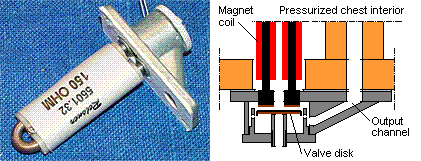 The electro-pneumatic interface used in most cases
here is
a Reisner chest magnet with
150 Ohms resistance, driven with 12 Volts.
The electro-pneumatic interface used in most cases
here is
a Reisner chest magnet with
150 Ohms resistance, driven with 12 Volts. Initially, consider the actions within this device. The first delay component is electrical in nature. When the drive voltage is switched on, the current and the magnetic force on its armature will grow only gradually toward the stationary values determined by voltage and resistance. This is because of the inertial inductance of the magnet coil. At some point the magnetic force is enough to pull the armature, being a small magnetic disk, against the force developed on it by the air pressure. The disk then flies toward the magnet and the output is switched from chest pressure to atmosphere in another few milliseconds.
When the electrical switch is opened for turn-off the inductance of a bare magnet induces a violent voltage spike that would cause arcing in a mechanical switch, or immediately kill a semiconductor switch. To avoid this it is customary in semiconductor switch designs to install a freewheel diode to limit the voltage excursion to the supply voltage. A consequence of the diode is however that it will take some more time until the energy of the collapsing magnetic field has been dissipated in the coil resistance, such that the valve disk will return.
| Reisner |
Wurlitzer |
Unit |
|
| Coil resistance |
150 |
175 |
Ohm |
| Coil inductance |
0.30 |
0.32 |
H |
| Bottom hole diameter | 3.9 | 3.3 | mm |
| Pallet diameter |
11.2 |
11.2 |
mm |
| Pallet weight |
435 |
650 |
mg |
| Pallet throw |
0.84 |
0.85 |
mm |
In both magnets the bottom seat is on a threaded plug such that pallet throw can be modified away from the factory setting. This setting is close to what is defined in the appendix below as "fully open".
Four different electrical connection principles were tested, as outlined here.
Diode stands for the inclusion of a freewheel diode to protect a semiconductor switch from over voltage when opening.
Since such a diode will increase turn-off time, a few countermeasure alternatives were added. Zener stands for the inclusion of a 12 V Zener diode such that the voltage across the switch at turn-off is higher than the supply, but now limited to about twice that voltage. Also a functionally equivalent alternative is shown, but this time using a 24V Zener diode connected at a different place.
The final variant examined is Resist where the magnet is series connected with a passive resistor, here arbitrarily selected to have the same resistance as the magnet coil. This requires the supply voltage to be doubled but speeds up the magnetic field collapse at turn-off. An additional merit is that turn-on is also speeded up since initial voltage to the magnet is then doubled.
Turn-on times increase with pressure since the drive current and magnetic force must go higher before the pallet is moved. It is seen that turn-on times are the same for all drive alternatives except Resist where the doubled initial magnet voltage increases speed.
Turn-off times go down with increasing pressure for an analog reason. But a most striking feature is that the electrical connection alternatives gives such a marked difference in turn-off times. This is a memento in restoration work where the original Mech variant might be substituted by the Diode alternative, should a modern solid state relay be installed. This will overthrow an earlier balance between on and off times. While turn-on remains the turn-off times might then increase enough to be musically relevant, notes being slightly prolonged.
A conjecture is that the Wurlitzer magnet has a more efficient magnetic circuit, probably due to its greater pallet thickness. This promotes shorter turn-on time and is good for handling higher air pressures. On the other hand it causes a large asymmetry in on vs. off times. Particularly at low pressures the pallet sticks a rather long time to the magnet, until the magnetic force has declined enough that the air pressure can push the pallet back to its passive position. Probably turn-off time can be shortened by installing a thicker gasket between the magnet and the pallet.
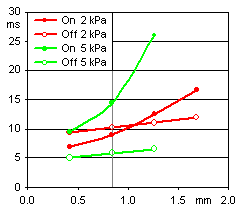 The turn-on and -off times of the Reisner magnet were
measured at two pressures with Diode
drive and varying its easily adjustable pallet throw. The original
throw setting 0.84 mm is indicated with a vertical line.
The turn-on and -off times of the Reisner magnet were
measured at two pressures with Diode
drive and varying its easily adjustable pallet throw. The original
throw setting 0.84 mm is indicated with a vertical line.The electric current has essentially stabilized after 30 ms, and if the valve has not switched by then it will never do. At a pressure around 6 kPa (24 inWC) the magnetic force is no more enough to pull the pallet unless the throw is reduced below nominal. Even a small decrease in throw will increase pressure handling capacity a lot, at some sacrifice in flow capacity.
Turn-off times are controlled by pressure (and electrical connection princple) but are rather insensitive to throw.
There is no reason to adjust throw to be greater than the original and optimal 0.84 mm setting since this would increase all times and reduce pressure handling capacity, without improving flow capacity. This Reisner magnet appears to be optimized for somewhat lower pressures than the Wurlitzer, perhaps the range 1 to 3 kPa (4-12 inWC).
 The photo shows a measurement rig
for
output pressure and valve stem displacement.
The valve stem partially
interrupts the light path in the infrared LED/sensor reading fork
mounted on a small green PC card. Behind the support rig a pressure
transducer is connected with a plastic tube to the valve output. The
output blows to the exterior through a 10 mm piece of 3 mm i.d.tube
constriction.
This allows a flow near 0.4 liter/sec at 2 kPa pressure.
Such a constriction, essentially smaller than the valve, is necessary
for a downstream pressure to build up when the valve opens.
The photo shows a measurement rig
for
output pressure and valve stem displacement.
The valve stem partially
interrupts the light path in the infrared LED/sensor reading fork
mounted on a small green PC card. Behind the support rig a pressure
transducer is connected with a plastic tube to the valve output. The
output blows to the exterior through a 10 mm piece of 3 mm i.d.tube
constriction.
This allows a flow near 0.4 liter/sec at 2 kPa pressure.
Such a constriction, essentially smaller than the valve, is necessary
for a downstream pressure to build up when the valve opens.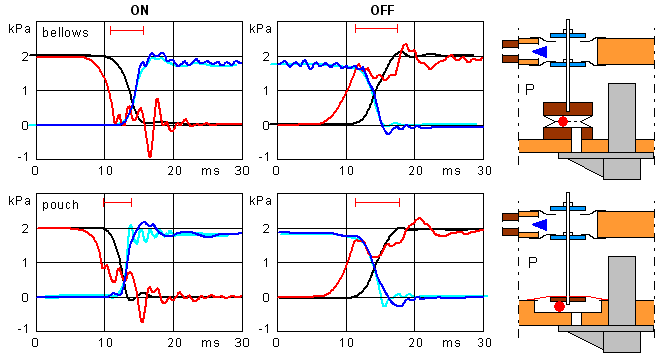
 The red
traces show the pressure inside the bellows or pouch cavity and
were recorded simultaneously with the output pressure in dark blue. The
black displacement was taken in another session, again together with
output pressure, this time rendered in light blue. These blue graphs
should ideally have been identical. The small fast oscillations (around
700 Hz) slightly obscure what is happening. They are not relevant to
the function of the valves but come from uncontrolled acoustical
resonances in the cavities, channels and probe tubes.
The red
traces show the pressure inside the bellows or pouch cavity and
were recorded simultaneously with the output pressure in dark blue. The
black displacement was taken in another session, again together with
output pressure, this time rendered in light blue. These blue graphs
should ideally have been identical. The small fast oscillations (around
700 Hz) slightly obscure what is happening. They are not relevant to
the function of the valves but come from uncontrolled acoustical
resonances in the cavities, channels and probe tubes. In this case the
output seat was a 12/10 mm dia. tube. Two different
puffers were compared, one small but adequately sized, and one
oversize. Puffer dimensions
for the cavity
below the leather and
pallet
diameter is as follows:
In this case the
output seat was a 12/10 mm dia. tube. Two different
puffers were compared, one small but adequately sized, and one
oversize. Puffer dimensions
for the cavity
below the leather and
pallet
diameter is as follows: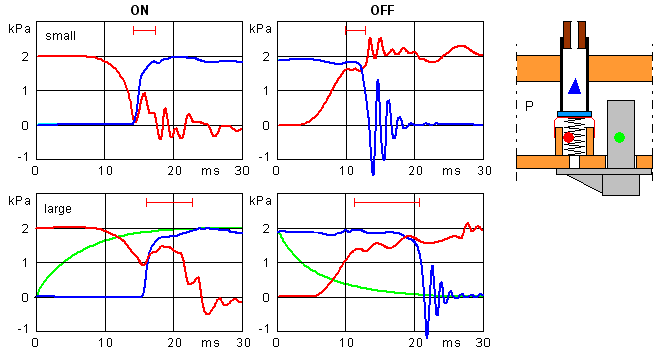
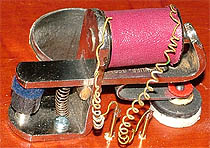 The
direct action magnet of comparable size at hand was made by
Laukhuff and has a 75 ohm resistance.
The
direct action magnet of comparable size at hand was made by
Laukhuff and has a 75 ohm resistance. 
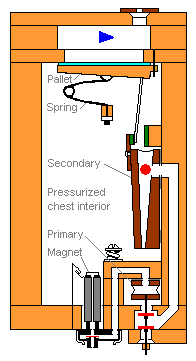 The following measurement was taken
on an offset wind
chest of a Wurlitzer style E theatre organ, currently in restoration.
The magnet and primary valve are similar to the type illustrated above,
except the valve disks are differently placed such that the output
pressure characteristic is inverted.
The following measurement was taken
on an offset wind
chest of a Wurlitzer style E theatre organ, currently in restoration.
The magnet and primary valve are similar to the type illustrated above,
except the valve disks are differently placed such that the output
pressure characteristic is inverted.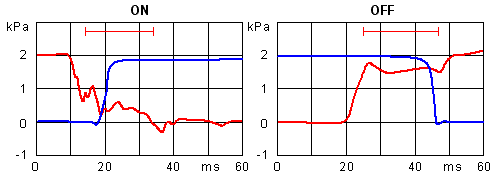
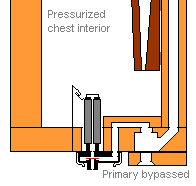 It has been suggested one might do away with the primary
amplifier valve in the Wurlitzer action, and bypass it by a slight
modification as shown in this figure.
It has been suggested one might do away with the primary
amplifier valve in the Wurlitzer action, and bypass it by a slight
modification as shown in this figure.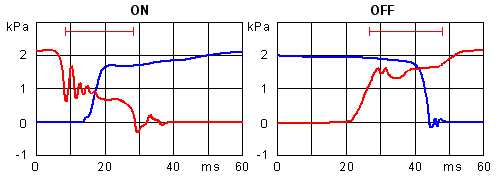 Again the blue
traces are for the output pressure reaching the pipe, the red ones the
internal pressure of the secondary (now only) bellows. The bars at top
indicate the time intervals the bellows is contracting and expanding.
Again the blue
traces are for the output pressure reaching the pipe, the red ones the
internal pressure of the secondary (now only) bellows. The bars at top
indicate the time intervals the bellows is contracting and expanding.